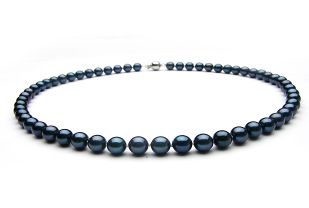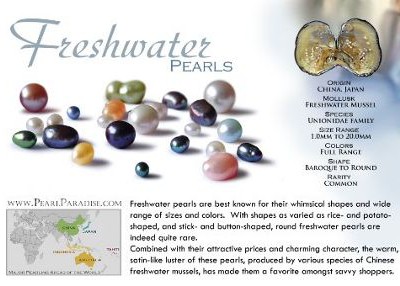The pearl buyers can be divided into two groups: those belonging to the group one want to buy a pearl jewelry where the pearls look nice, no blemishes on the surface, they gleam, if it is a strand, the pearls have matching colours, etc, .with one word, the pearls are perfect. They do not really mind if such perfection has been achieved by sacrifice of changing their original appearance and/or chemical structure. They would accept that the pearls were treated.
Members of the other group think otherwise. In our high-tech days, where almost nothing is what is seems, the most important factor for them to have a pearl jewelry with pearls that they are the same when they emerged from the mollusc. No matter if there are some small pits, blemishes on the surface, no matter if not even two pearls in a strand would match.
Thousands ot tons of pearls are harvested annualy but most of them would not meet the requirements of the market. In order to make them salable they have to be treated, enhanced. When the pearls are harvested, the pearl farmer can decide what to do with the low quality pearls: He can peel these pearls and reuse their nuclei. The pearls can be crashed and sold as pearl-powder (reputedly it is beneficial on the human organ..), they can be set in cheap fashion jewelry and sold on local market. The last option is to sell these pearls to wholesalers, who will have them treated, enhanced.
Pearls are treated in order to:
- increase their luster
- conceal or eliminate the original imperfections
- achieve colours required
Treatment of pearls goes back centuries. Pearl polishing and/or buffing is one of the oldest practices. The pearls can be tumbled in fine salt solution, with natural materials like eg. slivers of bamboo, eucalyptus chips, nowadays even pulverized precious-metal dust. Sometimes also beeswax or other chemical substances are used in order to conceal small imperfections and to improve the lustre. The beeswax can peel soon and the chemicals can be harmful on the nacre.
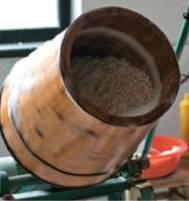
Pearls in buffing drum
Cleaning and polishing are followed by other treatments, the oldest method is the bleaching. Due to the thin nacre layer most of the akoya pearls are not as white as expected: the brownish colour of the conchiolin can be visible. These pearls are soaked in a hydrogen peroxide solution changing the colour pigments of the pearls to white. In order to achieve a uniform white colour most of the freshwater pearls are bleached, too. During the bleaching period intense light of about 40°C is applied. Unfortunately the effect will not last forever. Just take a look at many akoyas purchased many decades ago, they have already yellowed.
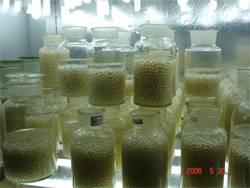
Akoya pearls in hydrogen peroxide solution
Heat treatment of pearls is a relative new technique for enchancing the lustre.The method is similar to face skin tightening. First the pearls are heated whilst a fraction of moisture content of nacre is removed, then they are cooled down. It effects that the outer nacre layers are pulled together resulting in higher lustre. Besides also special chemicals are applied in this process. All akoyas pearls, most freshwater pearls as well as lots of South Sea pearls undergo this process.
Since there is a great demand for golden pearls, no wonder that techniques have been elaborated to change other low-grade South Sea pearls to gorgeous golden pearls. Both dying, staining and heating process are used for this reason. In the latter case the pearls are heated to a relativ high temperature 70-80 degrees Centigrades.
Sometimes it happens that low-grade pearls are coated with a thin plastic layer, similar way as faux, or imitation pearls are produced. In order to have the appearance of Tahitian pearls sometimes silicone polymers are applied, see below:
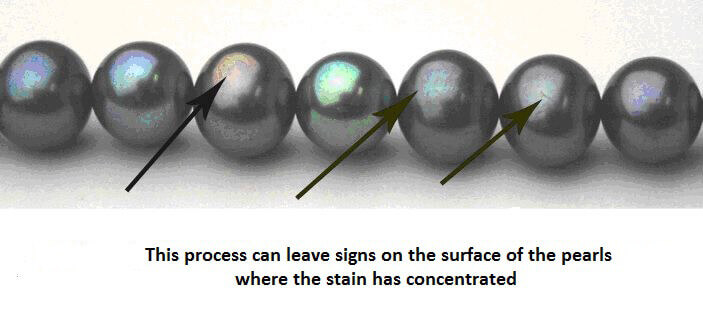
This is the simplest way to change the colour of the pearls and of course also the simplest one to detect it. The target of this method can be also to conceal to surface blemishes.
In order to change or enhance the colour of the pearls also better methods are available. Since the pinkish overtone is sought-after mostly with the akoya pearls, a mineral salt solution is used while heated. The pearls rest in the solution for several weeks until the pinkish glow is achieved.
For the next colour treating method silver nitrate is used. When pearls are immersed in silver nitrate and ammonia solution they obtain a dark colour (black, dark-blue, dark-violet). In addition to silver nitrate, numerous unorganic and organic chemicals are used such as hydrogen sulfate, silver salts, cobalt, potassium, etc. Use of steady fluorescent light is essential during the treatment.
The original colour of pearls can be altered when
- the colour of the nacre is changed
- the colour of the conchiolin is changed
- the colour of the nucleus is changed
Of course it happens that the colour-changing process has multiple effect. Most treatments have effect on the nacre of the pearls, while in case of the pinking treatments the chemicals are usually concentrated in the conchiolin. In order to change the colour of nucleus usually two kinds of techniques are common. With application of some chemical solution, like silver bromide the colour of the nucleus will turn to black or brown and this colour is visible through the light nacre layer.
A few decades ago a new method was patented in Japan. Using this new method pearls were exposed to gamma-ray irradiation (applying Cobalt 60 isotops) for darkening their akoya pearls. The originally yellowish, creamish, white pearls turned to different dark colours. This method is based on the effect of the irradiation on the manganese contained in the pearls, more exactly in their nuclei. The nuclei are made of freshwater mussel whose manganese content is several orders of magnitude higher than that of marine oysters.
This technique is applied also in case of South-Sea pearls. Practically all sorts of dark colours can be achieved. The thinner the nacre, the more visible is the changed colour of the nucleus. It means that using this method the colour of pearls with thick nacre cannot be transformed to too dark. Besides laboratory tests have detected that the discolouration of pearls is caused partly by the protein pigment alteration in the nacre.
For one of the latest treatments Niobium (previous name Columbium) is used. As one of the most wanted alloys, it is used in the metallurgy. The Niobum in form of dust and vapour reacts to oxygen while creating an oxide layer on the pearl’s surface. The more layer is created the more colourful the pearl will transform, thus gorgeous Tahitian-like pearls (peacock) can be created.
Most of the above mentioned treatments can be detected. In most cases a good, trained eye is sufficient. Sometimes the treatments can be proved only by use of special gemological instruments. In more sophisticated cases (e.g. South-Sea pearls with thick nacre) special instrument, like ESR spectroscopy is required.
Some of the treatments are harmless to the pearls, others are harmful. Chemical treatments affect the durability of the nacre. The bottomline is whether any of these treatments are acceptable to the customer or not. Provided that the fact of treatments are disclosed to them. If so, it is already up to the customer if she/he is still willing to buy it. But if it is not disclosed, even the vendor tells long stories, well, it is called simply fraud.
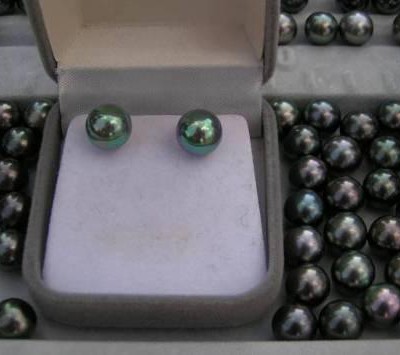
I have put an earring box with a pair of brilliant green pearls among some Tahitian pearls.
Would you guess what these two gleaming pearls are made of? Well, simple mother-of pearl. They are like mirrors but lifeless. Of course noone would sell them as real pearls.
Personally I have seen at the several jewelry shows hundreds of large-sized Tahitian pearl strands glittering in totally uniform colours (peacock, green, even blue) and when I asked the vendors if these nice pearls were treated or not, all of them refused it.
The trade usually knows what is going on with the pearls. The end-customer has NO IDEA. The contact between the end-customer and his/her jeweler is similar to their contact with the doctor. The client expects true diagnose from the doctor as the customer expects true story about the pearl.
Below you can find some adds, try to check if they are true or false.



